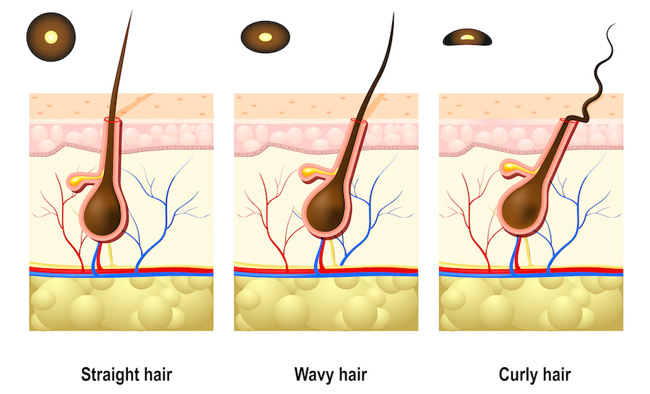
Why do people of African descent have a unique hair texture?
April 26, 2005

- Related Topics:
- Hair texture,
- Complex traits
An undergraduate from Georgia asks:
“Hair biology has always interested me and no matter where I look I can never find the appropriate answer to my question. Now I understand that African American hair has a curly follicle, which is what produces the curly hair texture as in many ethnic groups, but how come African Americans are essentially the only ethnic group with "coarse" curly hair? I don't mean to be rude while asking this question, but it has always been of interest to me. I want to understand the genetics behind it.”
Having an interest in understanding our differences isn't rude at all!
Hair texture is just one of the many obvious physical differences that exist between ethnic groups. Although hair growth rate, size, shape and texture are unique to every person, we can see trends among groups of people.
While genetics are likely to be involved in determining these traits, not much is known yet about the actual genes involved. So what is known about hair type?
Hair follicles are tiny pockets in our scalp out of which our hair grows. As you hinted above, the thickness and texture of our hair depends on the size and shape of these follicles. They help to form and contour our hair as it grows.
Our hair thickness results from a combination of both the size of the follicles themselves and how many of them line our scalp. The size of the follicles determines if the individual hair strands are thick or thin. Large follicles produce thick hairs. Small follicles produce thin hairs. It is that simple!
Equally important to the feel of our hair is its density, or the number of hairs on our head, which is determined by the number of follicles on our scalp. Lots of hairs contribute to more dense, “thicker” feeling hair, while sparse hair means “thinner” hair. On average, our heads are covered with over 100,000 follicles!
Our hair texture can range anywhere from pin-straight to extremely curly. Follicles that are round in cross-section give rise to straight hair. Follicles that are more oval in shape cause curlier hair to grow. Very tightly coiled hair is due to the nearly flat, ribbon-like structure of their follicles. This hair texture is very common in people of African ancestry.

Not only is African hair often coiled, it also has a unique texture. So why is this?
African hair produces plenty of protective oils, called sebum, which keeps our hair healthy. In fact, African hair actually produces more oils than Caucasian and Asian hair. However, due to the tight curls, the oil doesn’t spread evenly along the hair fiber.
Without lubrication, the fibers can become dry. This causes the strands to become more brittle, which contributes to the hair’s texture. Very curly hair from all ethnic groups often becomes brittle due to the lack of oils along the hair strand, but to a lesser extent.
The brittleness of African hair adds to the illusion that it cannot be grown long. The tight curls create stresses at each turn in the hair fiber. The hair strands become fragile, making them prone to breakage. As a result, tightly coiled hair tends to stay quite short. So is this hair quality genetic?
There are two reasons why we believe African hair texture is genetic. Firstly, the texture is universal in Africans, while nearly absent from other ethnic groups. Secondly, it is consistently passed down to the children in each new generation.
Despite this, I could not find any identified gene shown to be responsible. Of course, that doesn't mean that a gene isn't involved! Scientists have just not found it yet. However, we may be able to pull clues from rare occurrences of non-Africans with a similar hair texture.
You may think that highly coiled hair is unique to those of African ancestry, but it is not. It is, however, quite rare in other ethnic groups. So rare, in fact, that when it is seen in Caucasians and Asians it is referred to as a syndrome: “Woolly Hair Syndrome”.
Described in much the same way as African hair, the hair of people with Woolly Hair Syndrome is characterized by dry, tightly spiraled fibers. You may be wondering if it initially arose from the mixing of different racial gene pools, but that is not thought to be the case.
Since Woolly Hair Syndrome is so infrequent there is little reliable information about it. The actual causative gene or genes have not been singled out yet. However, the syndrome does run strongly in families.
When the exact gene that causes a syndrome is not known, scientists look at how the trait is passed along in families. It appears that most cases of Woolly Hair are inherited dominantly. This means only a single copy of the syndrome-causing version of the gene is needed, passed down from either the father or the mother.
It may be possible that the gene responsible for Woolly Hair Syndrome in non-Africans contributes to the texture of African hair as well. If this were the case, the "non-woolly” version of the gene is virtually exclusive to Caucasians and Asians. This would explain the straight hair common among these ethnicities.
Likewise, the gene version that causes textured hair is nearly exclusive to Africans. Its high prevalence could be explained by the fact that most Africans are carrying two copies of the dominant gene. This would assure that the same hair texture is maintained in the population.

Whether the gene responsible for Woolly Hair Syndrome in Caucasians causes the similar hair texture seen in Africans is hotly debated. Differences between the two types of hair have been noted. For example, the curls of African hair tend to lie as separate ringlets, while the curls of Caucasians with Wooly Hair Syndrome tend to merge.
This model also raises questions regarding the hair texture of children of mixed race. Using this model we might expect children with one African hair texture gene and one Caucasian hair texture gene to have the dominant African hair texture, but this does not always appear to be the case. An "intermediate" texture is often seen.
As time passes, genetics will certainly bring to light the reason behind many of our ethnic differences. When that day comes, there may then be a more definitive answer to your question.

Author: Anne Tecklenburg Strehlow
When this answer was published in 2005, Anne was a Ph.D. candidate in the Department of Genetics, studying the genetics of Huntington’s disease in Rick Myers’s laboratory. Anne wrote this answer while participating in the Stanford at The Tech program.
 Skip Navigation
Skip Navigation
